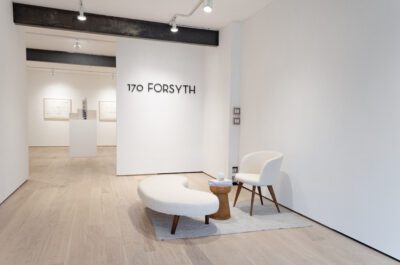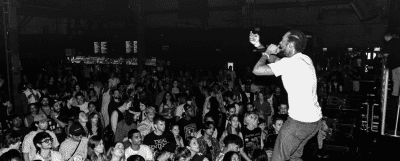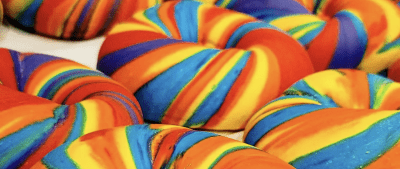Did the real Andy Warhol just stand up?
How Andrew Rossi's 'The Andy Warhol Diaries,' streaming now on Netflix,' humanizes an icon by examining his great loves
It’s hard to imagine today’s pop culture without Andy Warhol’s influence. Lil Nas X, TikTok kids, and Lady Gaga all owe a debt—whether they know it or not—to the counterculturist. But to make the jump from counterculture to the mainstream, Warhol himself had to meet the public on their terms.
Warhol was never comfortable talking about his sexuality and that was exactly how people outside of his circle liked it. Audiences, and eventually scholars, used Warhol’s reluctance to share his private life as a way to rationalize away his gayness. It allowed people to feel comfortable with his perspective of popular culture.
Even later in life, Warhol transformed into “the way people want Andy Warhol to look,” says director Andrew Rossi. The artist’s flair met 1980s decadence when he guest starred on shows like “The Love Boat” and “Wrestlemania” and hosted his own talk show in the early days of MTV called “Andy Warhol’s 15 Minutes.”
By allowing himself to become a pop star, Warhol the person disappeared in the eyes of the public. He was sold as a master of mass reproductions, and for years after his death he was mass-produced himself.
Only in the last decade has there been a public-focused reassessment of Warhol’s work through the lens of his personal life: A current exhibit at the Brooklyn Museum explores the artist’s relationship to the Church, his faith and his queerness.
Now, Director Andrew Rossi explodes the idea that Warhol’s work is impersonal in his new six-part docuseries “The Andy Warhol Diaries” for Netflix. Using over a decade’s worth of Warhol’s personal journals, Rossi uncovers the side of Warhol he hid from the world: his sexuality, relationships, and humanity. And he does it, paradoxically, with an assist from artificial intelligence.
Brooklyn Magazine spoke with Park Slope-based director Andrew Rossi about resurrecting Warhol’s voice to narrate the docuseries using AI. Rossi discusses how Warhol’s queerness is inextricable from his art and the disproven rumor that Warhol was celibate because of his faith. We talk about how Warhol’s Catholic Byzantine faith influenced the iconography of his portraits and how he anticipated the development of celebrity in the decades after his death.
There’s a part in the documentary where Jessica Beck, curator at The Andy Warhol Museum, says “No one wants to talk about Warhol having relationships that are important to his body of work, but I think that Warhol’s biography is important for some of the reading of the work, because this idea of intimacy or queerness is always there.” That seems like the thesis of your documentary. How did you discover that about Andy and why did you make it the documentary’s through line?
I started the process of making the series back in 2011 when I reread the diaries, while I was touring a film in Europe that I had just made, and I was reading it in my hotel room, in coffee shops alone. I was astonished to hear Andy talk about this person, Jed Jonson, who lived in his townhouse, and who he was having fights with. And then his lust for Jon Gould, and how passionate he was about pursuing him. These moments were like a revelation to me, I had not heard about Jon Gould at any point, and I had been following Andy since I was in high school, and read several books about him. Immediately I felt this is the new component of Andy’s story. I wanted to understand if I were to plot out the progress of these relationships, and the artwork that he made, what kind of connections one could draw to them. And so immediately I knew that the series would be a love story, but also that the diaries would become like a roadmap to decode Andy’s true self and his artwork.
Some Catholic circles now accept Warhol but it’s on the assertion that Andy may have been gay but he was celibate. How do you respond to that knowing what you know about his relationships?
The notion that queerness can be kept in check somehow with behavior that doesn’t include physical intimacy within the Catholic world and Catholic teachings is very sad. I’m Catholic, and I know that for me, it was a struggle to understand my identity as a bisexual man, while also trying to stay within the religious background that I grew up in going to Catholic school, until eighth grade. The other thing that is distressing about the idea that celibacy somehow changes Andy’s identity is that asexuality is also another category of sexuality, which is included in the LGBTQIA plus umbrella. And so, there’s also a stigma associated with that identity that is just part of a whole toxic mix of Catholic views on anything not heteronormative.
What came first, the idea to recreate Andy’s voice with AI or the technology to do it?
I guess it was somewhere in the middle. I finished this movie “Page One” about the New York Times and that’s when I came up with the idea of doing another film that takes a novel way into a big mythic figure to understand them on a human level. So back in 2011, I was reading Andy’s diaries and that’s when I knew that I wanted to hear Andy’s voice not mediated by an actor or a narrator. But really feeling like it was Andy talking to you. At that point, I believe that there were some articles about Adobe having within the Pro Tools Suite some technology, but this is before the more complex approaches to deep fakes and things that emerged around 2016. When those started to develop … it made me feel like there would probably be an opportunity to make it happen.
Andy once said, “Machines have less problems. I’d like to be a machine …” And now he is.
Andy wanted to be a machine because it would perhaps be another form of armor to protect his very sensitive heart from the pain of living in a world that he felt like an outsider to, and did not accept him. He had himself made into a robot, he had himself made into a hologram. And so the idea of taking his words in the diaries, which are already of self-portrait-in-text, and making that auditory felt like a way to honor his artistic practice of using the mechanical to distance himself from the art objects.
Talk about how Andy’s Catholic Byzantine faith influenced the iconography of his portraits?
So Andy’s mother Julia took him to services at the St. John Chrysostom Byzantine Catholic Church in Pittsburgh every weekend, several masses back-to-back on Sunday. I filmed in that church where you see the iconostasis that includes several images of saints with gold leaf paint, in very static poses with a gesture. Those look very similar to Andy’s portraits of Marilyn Monroe and Liz Taylor, and even “Triple Elvis.” Many art historians believe that Andy internalized and absorbed the formal look of those icons and also the almost-glamor that they projected within his world growing up. In Pittsburgh, he also was consumed by Hollywood pinup stars like Shirley Temple and others that appeared in magazines that he was able to get. But as Bob Colacello says, the church also is a very homosexual institution. Many people who went into the priesthood did so because they didn’t feel that they could live as out gay men. And so there is an aesthetic that is Catholic that is consistent with Andy’s iconic glamorous approach.
I’m thinking about people today who live their public life as pop personas. In terms of superstars, I can think of Kim Kardashian, Kanye West, and in his own way, even Wes Anderson. Part of Andy’s legacy is for us to have living, breathing icons, on whom we can attach our hopes and dreams and anger and frustrations.
I think it’s so much a part of our contemporary lives. The idea of converting your name from Andrew Warhola to Andy Warhol and putting on a white wig and making yourself a character is so much a part of our lives in big and small ways. On a big level, you have Lady Gaga, who takes on a new name, and performs this character both on stage and in her personal life. But in smaller ways, we are all projecting a happy image often of our lives on vacation and with our families or doing cool things on Instagram. TikTok itself is a fascinating platform because it’s all about either dancing or doing something in a short span of time that is performative. It is the most explicitly performative of the social media platform so far, it seems. You have people like Emma Chamberlain and James Charles and other influencers who are very clearly embodying an iconic image in order to participate in this new currency.
Do you think that’s something Andy would participate in?
He would have felt at home with the idea of making short bursts of himself saying something or doing something. “Andy Warhol’s TV” approximates that and there were cold opens to the show in which he would appear in a really artificial background describing who’s going to be on the show. He always felt very awkward doing that. But then he learned to embrace that image of himself and by the time he’s appearing on “The Love Boat” in 1985, he is saying that he finally looks the way that people want Andy Warhol to look with a silver jacket, designed by Stephen Sprouse. So he would have had fun with the fashion and with the performance would be my guess.
You might also like 


























